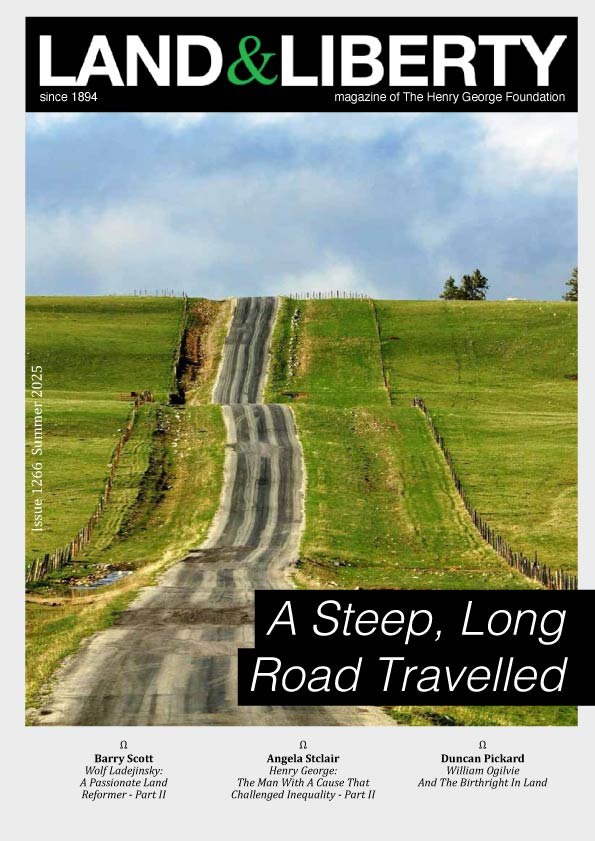Get Updates
Progress without Poverty
Page 5 of 7
Comparison of Economic Models
We may now look at our two economic models drawn from different centuries and see how they relate to each other. We need first to reconfigure the Ricardian economic rent model so that instead of showing the varying value added on different sites by the input of a unit of human enterprise, labour and capital it shows the varying amount of those inputs to yield a unit of value added.
Figure 8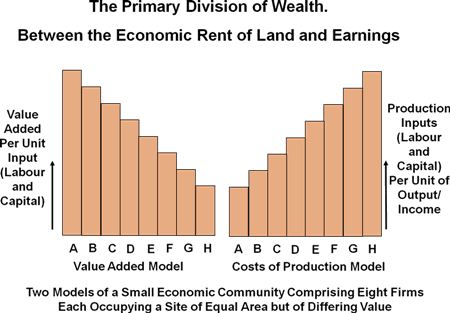
Figure 8 shows the same economic community in these two configurations.
Figure 9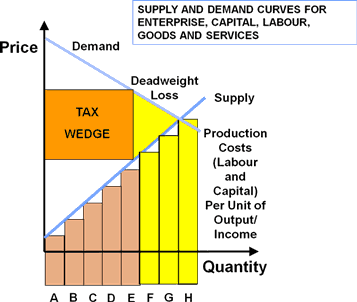
Figure 9 superimposes the supply and demand curves shown in Figure 6. upon the unit value added configuration of the Ricardian model. The effect of the tax wedge may be clearly seen, the three most marginal sites are rendered unviable and stop producing, casualties of the deadweight loss.
It is now useful to place these theoretical findings in the context of current UK economic realities.
Figure 10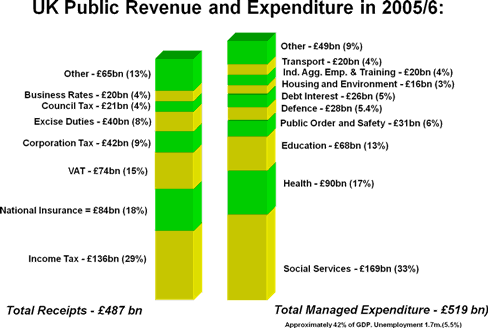
Figure 10. shows the UK government tax revenue and public expenditure. On the tax revenue side we note that the single largest amount is drawn from taxes levied on employment and enterprise directly whilst a very large share is levied upon trade, sales and value added. We should note however that whatever the appearance, taxes must ultimately be drawn from the value that is created by productive enterprise – there is no other source of new wealth. When taxes are drawn from trade and sales we should mark that these all feed back into the expenses that individuals must pay and pass on to the productive firms that employ them in determining the least they are willing to accept.
On the expenditure side we may note how small a fraction is spent upon both (a) the provision of essential services, needed by everyone but which by their nature are monopolies and (b) the protection of society by means of law and order provisions and defence. These may be contrasted with the large amounts it is necessary for government to spend upon both (a) the alleviation of poverty through the provision of a wide and widening range of social services and (b) health and education services that, while not natural monopolies, are beyond the means of most people to provide for themselves out of earned income. The link here, between this phenomenon of generally low earned income, insufficient for individuals and families to provide for themselves their essential needs, and the general depression of earnings operating on the firms and individuals that produce all the country’s wealth is stark. We see that earnings are depressed by two intimately related aspects of the tax system.
The government first fails to recognise the duty that individuals and corporations owe to the community that permits and protects them to enjoy exclusive possession of that which the community as a whole has provided, and a free gift of nature – the land itself. It then compounds the error by taking by force, or the threat of force, a large portion of that which people and corporations have created through their own efforts and enterprise.
The Effect of a Remedy
Let us now speculate upon the effect that remedying this injustice and mismanagement might have on the national economy.
Figure 11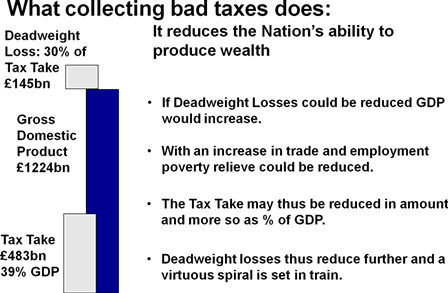
Figure 11 shows the gross national product together with the tax take of around 40%. Taking the governments own estimate of the deadweight losses (30%) associated with their current tax arrangements we see how if the method adopted did not incur such losses (e.g. LVT replacing Income and other taxes) an extra 30% of value added would be added to the GNP.
This would increase the tax base and reduce the tax take as a percentage of GNP. Deadweight losses thus reduce further and a virtuous spiral is set in train. At the same time if Land Value Tax was the selected alternative the proportion of so called ‘unearned income’ would be reduced whilst more earnings would go to those who actually earned them. With more earnings available to those who work for a living there would be a reduction in the need for poverty relief expenditure and more people and families would be able to provide for all the services a modern and civilised society expects.
A word here may be called for with regard to the effects on the cost of housing as these tend to increase with people’s ability to pay. In fact of course, it is not the cost of the bricks and mortar that escalates but rather the value of the land on which a house stands. It is thus important that such a rise in the general level of earnings does not feed back into inflating land values and thus housing costs.
As we have shown, the effect of a Land Value Tax would be to exert a downward pressure on capital land values. We might note here that capital land values reflect the market’s estimation of the value of an indefinite stream of annual rental values. Where that full income stream is not available to the individual because government has collected a portion of it, the capital value can be expected to reduce. In this we should note that a Land Value Tax is not aimed at collecting a portion of the capital value (which would tend to decline over time) but rather the periodic rental value of the site. This might be expected to change over time with some locations becoming relatively more advantageous whilst others less so. The periodic re-assessment of their tax liability would reflect these variations and thus would truly reflect the (site owner) firm’s ability to pay.
The question of negative equity is usually raised at this point as it is noted that if capital land prices and hence house values fall those with large mortgages could find themselves in difficulty. Unfortunately this issue cannot be adequately addressed in this paper without increasing its length substantially; a few points however may be helpful.
- Negative equity becomes a problem for people with a mortgage when they are unable to keep up their monthly payments.
- It is thus linked to their employment and their level of earnings.
- The prospects for both are enhanced by a move away from currently damaging taxes and towards a benign tax on land values.
- The real problem with negative equity is one of debt.
- Unfortunately we have cultivated financial arrangements based upon the provision of so called ‘credit’ where the lender does not rely on the borrower’s capacity to produce new wealth themselves but rather on the collateral that he or she can provide.
- We have generated a system of creating new money that does not link directly to the wealth creating process (as true credit might be expected to do) but rather relies on an ever increasing growth of capital land values to guarantee past debts and fund new ones.
The advent of Land Value Taxation would thus be a stimulus to a long overdue and radical review of banking and money arrangements. This could lead to the establishment of financial institutions that were more concerned with facilitating the production of newly made wealth than with enabling the holders of money to make more money, whereby they are enabled to exercise a claim on the real wealth produced by others.
Donate Today
Bank Transfer
DonateHelp us minimise transaction fees and administrative costs by donating via bank transfer.
PayPal
To Gift Aid your donation, please request a Gift Aid Declaration Form >

